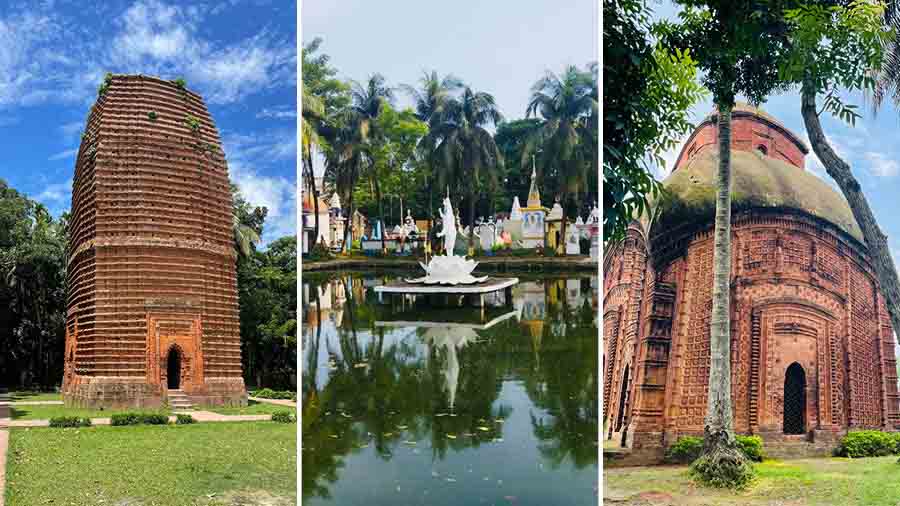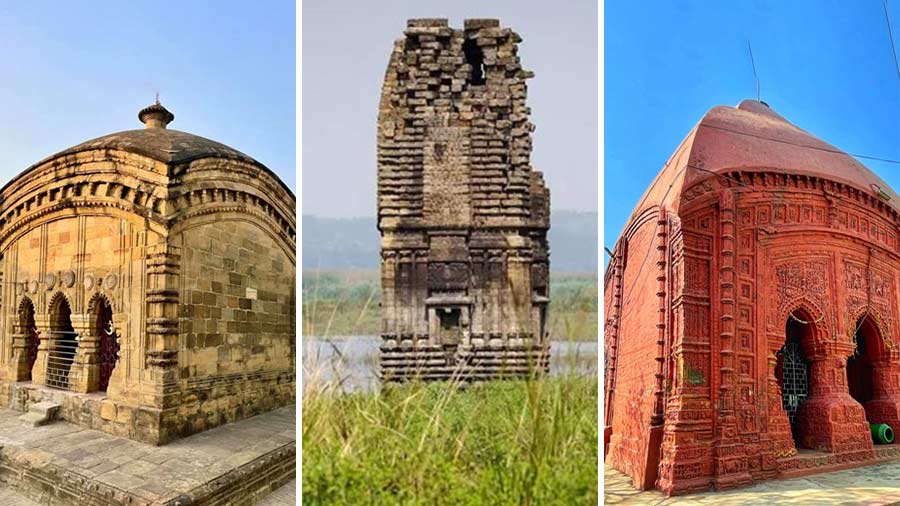My 79-year-old mother’s wish to see her birthplace led me to a short discovery of Bangladesh. I curated the trip with my travel agent to cover beautiful landscapes like the Barishal backwaters and historical temples and towns in addition to my mother’s ancestral home. I avoided the typical tourist circuit of Dhaka-Chittagong and focused on the southwestern part of Bangladesh, east of the Padma river, and parts of Rajshahi in the north, where we had to cross the Padma.
One of the most attractive aspects of our visit were the temples of Bangladesh. I would classify them into two groups. The first group comprises the late mediaeval temples with terracotta carvings. These are of archaeological and historical importance and some of them are no longer used by the community as places of worship. In the second group are the working temples with their own slice of cultural history. Here, I shall focus on the former.
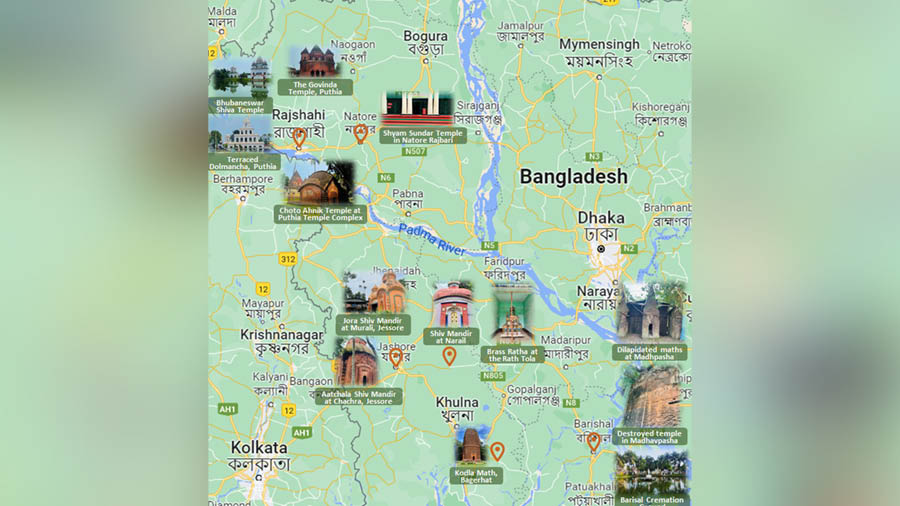
A map tracing the author’s journey through the temples in Bangladesh
The red terracotta temples, many of them intricately carved with scenes of daily life, retell mythological stories and dot the landscape of both Bengals. They are a testament to the love and care that our ancestors accorded to their spiritual practice. Having survived over a few centuries, they also provide a window into the soul of ahistorical Bengalis.
The Shiv mandir and Rath Tola in Kalia village, Narail
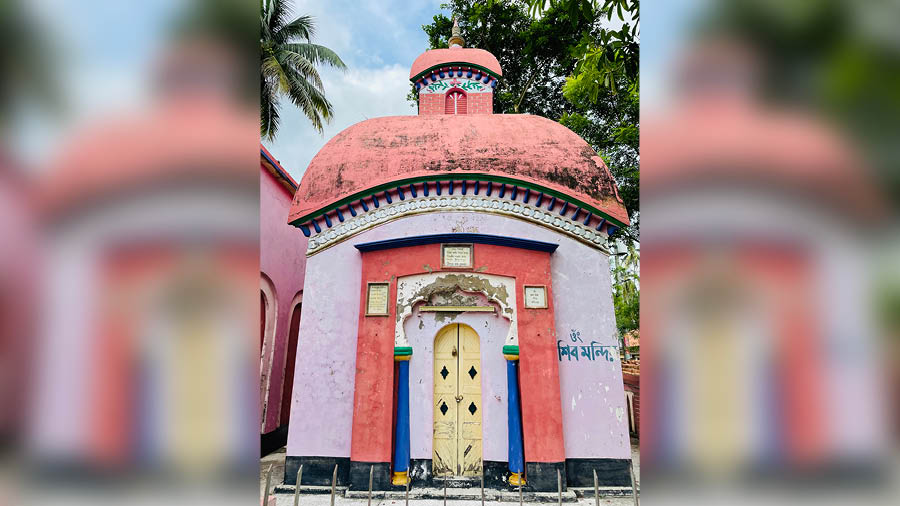
The Shiv mandir in Narail is still a functioning temple
We visited our mother’s ancestral home in Narail. The journey was beautiful across a stunning landscape of silver-grey rivers framed by different shades of green and reflecting blue skies. We stopped at the Jomidar ghat by the banks of the Chitra river in Narail before crossing the lyrically named Madhumati river on a ferry from Baruipara ghat. We found my mother’s house in the village of Kalia. More than half of the property’s grounds have been acquired by the Bangladesh government to build a college. The main house is in a dilapidated state, but the lower floors are still occupied. The adjoining temples, however, are very well maintained. The Durga Mandap and the Shiv Mandir are functioning temples. The brass rath dating back to the early 20th century in the Rath Tola is one of most unique raths I have seen. These temples had been transferred to debottor trusts, which helped them survive the worst excesses of the East Pakistan government.
Kodla math (cenotaph) in Ayodhya village in Bagerhat with its ridged rekha deul

The Kodla ‘math’ has had a facelift after being taken over by the Bangladesh government
This is the oldest terracotta temple I had the good fortune of visiting. Located in a tiny hamlet deep inside Bagerhat district, we approached it during our journey from Khulna to Barishal. There were children playing on the temple’s premises, but the improvement to the site after it had been acquired by the Bangladesh government was quite discernible. I compared the current state of the temple with the photo taken by David McCutchion (sometime in the 1960s) and the math was clearly in a better state than before.
The otherworldly Barishal cremation ground
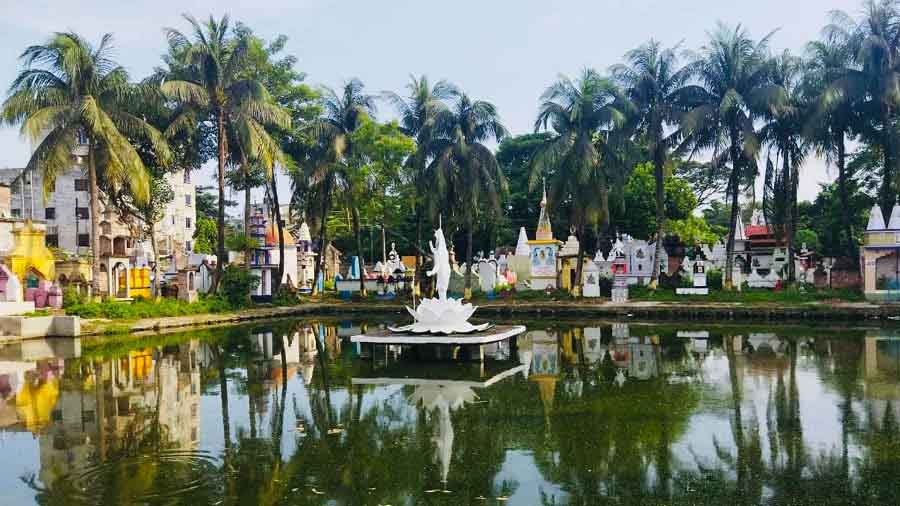
The Barishal Mahashashan
This made for an unusual sight as well as a strange experience. Somehow, I had never seen cenotaphs in a Hindu cremation ground before. The Barishal Mahashashan was teeming with thousands of cenotaphs or maths as they are called locally.
The destroyed temple and the dilapidated maths in Madhabpasha
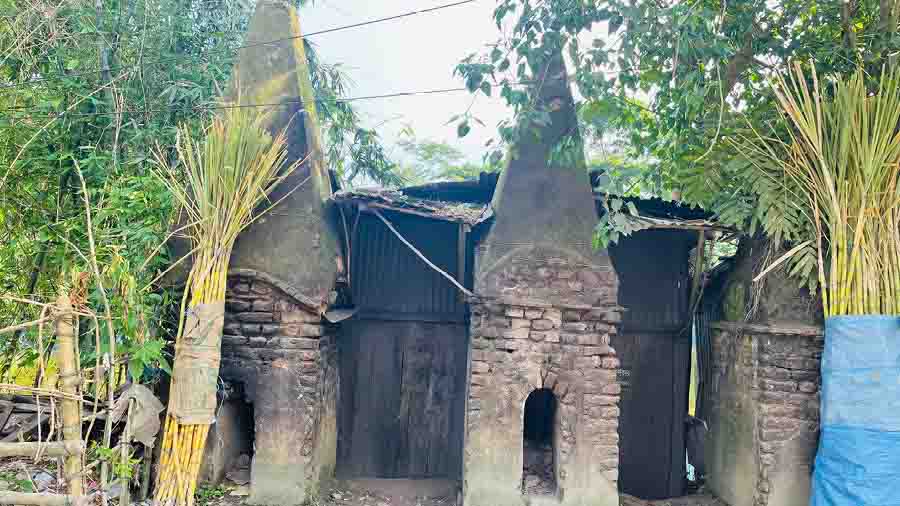
The ruined state of the ‘maths’ greatly disappointed the author
Madhabpasha in Barishal was a disappointment as the charchala temple that was seen and photographed by McCutchion was in ruins. There was no way to access the temple as it had been taken over by a giant banyan tree. The side entrances were blocked by a building and a sweet shop on either side. I went in through the sweet shop and was able to see the remains of the backside of the temple. The village of Madhabpasha still had quite a large sprinkling of dilapidated maths though.
The Govinda temple in Puthia
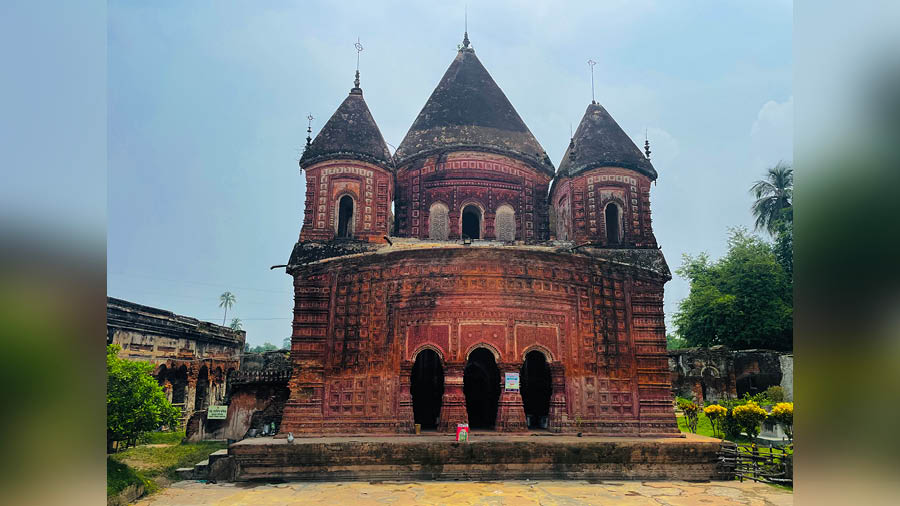
The Govinda temple was opened in the afternoon especially for the author’s mother
This stunning temple with its ornate carvings and Pancharatna charchala towers is located within the Puthia Raj Bari complex in Rajshahi. The Puthia estate was one of the largest zamindari estates in British India and dates back to Akbar’s time, when the family was rewarded with their mansab (rank) for helping Akbar’s commander Man Singh I put down an Afghan rebellion in the region. Visiting Puthia was also one of our sweetest experiences. The building was closed to the public till 2pm on the day of our visit, but on hearing that my mother had come all the way from India, they opened the side gates for us. There are a lot of benefits of being an Indian tourist in Bangladesh!
The Bhubaneswar Shiva temple in Puthia

A great example of the Pancharatna architectural style
This is the largest Shiva temple in Bangladesh. Built in 1823 by Rani Bhubonmoyee Devi, the widow of Raja Jagat Narayan Roy, it overlooks the Shiv Sagar lake. This ornate temple is an imposing and excellent example of the five spire style (Pancharatna) of temple architecture.
The Chota Ahnik temple in Puthia

This temple was designed for Rani Bhabani’s private worship
This is rumoured to be built during the reign of legendary queen Bhabani. Built in the Dochala style with its curved cornices, it was meant for the Rani's private worship. The larger Govinda temple can be seen in the background.
The Dolmancha temple in Puthia

Examples of other Dolmancha temples abound across Bengal
The imposingly terraced Dolmancha is one of the finest examples of its kind in both Bengals. It is also one of the largest I have seen. According to McCutchion, “The Dolmancha was most commonly built in the 18th century… they’re spread over the whole of Bengal, wherever Krishna was worshipped.”
The Shyam Sundar temple at Natore Rajbari
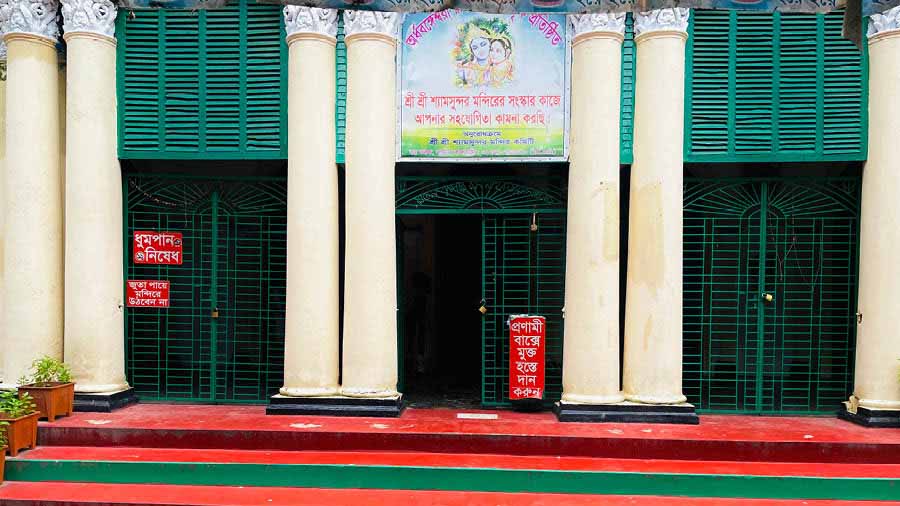
The Shyam Sundar temple often benefits from the fame accruing to Natore because of the ‘Banalata Sen’ poem
Natore is a name which comes up quite often in Bengali literature thanks to famous Bengali poet Jibanananda Das’s immortal lines about “Natore-er Banalata Sen”. Maybe it was the poet’s imagination, but the Natore princesses were famed for their beauty, especially the legendary Rani Bhabani in the 18th century. Natore also has an important role in the history of late mediaeval Bengal.
The Jora Shiv mandir in Murali, Jessore
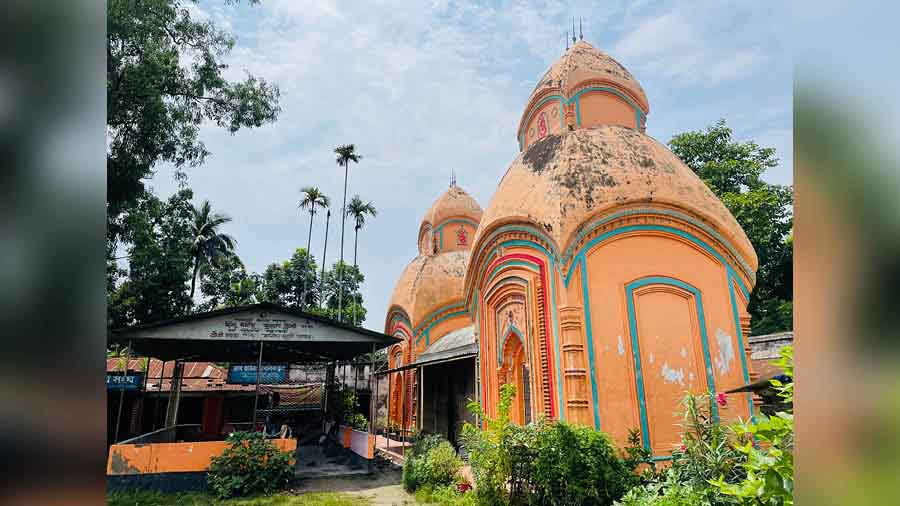
This temple has not been restored properly, according to the author
The Jora Shiv Mandir at Murali in Jessore has been defaced by paint. I have seen this kind of shoddy restoration in West Bengal as well, especially in the beautiful Raj Rajeshwar temple at Dwarhatta in Hooghly. This was disappointing to witness.
The Aatchala Shiv mandir in Chanchra, Jessore

A Shiv puja is held every month in this temple
This beautifully preserved temple was built in 1696 by local zamindar Manohar Ray. It is a functioning temple with Shiv pujas being held every month on full moon nights after the Bangladesh’s Department of Archaeology allowed it in 2017.
During our short trip I only had time to see a handful of temples, and wish to go back and see more, including the famous Kantajew temple in Dinajpur. Temples like these, dating back to the time between the 16th and 18th centuries, are all part of our great Indian temple-building tradition. They are also a testament to the revival of the Hindu faith following Chaitanya Mahaprabhu’s Bhakti movement in the 15th century, when there was a frenzy of temple building across Bengal. They are an invaluable part of our heritage, and I wish more Indians can visit them to get a better understanding of our shared past and common heritage with Bangladesh.
Koushik Chatterjee is an IT executive based in London. He is an avid traveller, writer, sports nut and quizzing enthusiast. He has competed in the UK version of BBC Mastermind. His pet passions include the Sanskrit language and the conservation of the late mediaeval terracotta temples of eastern India.
